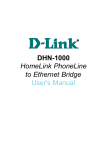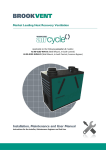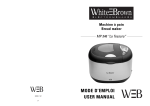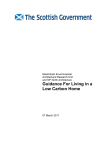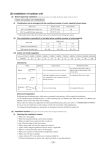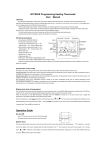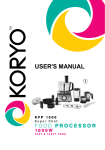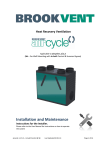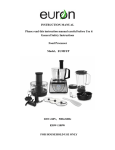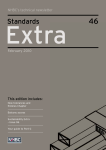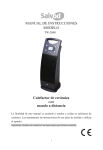Download Tackling Overheating in Homes Executive summary
Transcript
Tackling Overheating in Homes Survey findings Executive summary A survey produced by Sustainable Homes for the Zero Carbon Hub aimed to assess the degree of anxiety and uncertainty about overheating in UK homes. Respondents representing 208,047 homes shared their experience. Based on the survey responses, on average 20% of homes have experienced overheating in the last 5 years. 43% of respondents are extremely or very confident that those properties that have NOT experienced overheating problem do not present a risk of overheating in the future. In comparison 23% of respondents are not confident. Overheating risk assessment is routinely carried out for 59% of new build and 59% for existing homes. 65% of respondents believe that the level of concern about overheating in their residential properties is high or fairly high. However, over 34% of respondents stated that the level of concern is still relatively low. Further detailed information is contained in the report. Sustainable Homes Marina Place 17 Marina House Hampton Wick KT1 4BH Telephone: 020 8973 0429 Email: [email protected] Report prepared by Magda Bilinska Overheating survey findings – 8th January 2015 Page 1 Contents Introduction ...................................................................................................................................... 3 Background ...................................................................................................................................... 4 Prevalence of overheating ............................................................................................................... 5 Assessing overheating risk .............................................................................................................. 8 Future risk ...................................................................................................................................... 12 Summary........................................................................................................................................ 16 Appendices .................................................................................................................................... 17 Overheating survey findings – 8th January 2015 Page 2 Introduction This short survey produced by Sustainable Homes for the Zero Carbon Hub aimed to help gain a picture of how those who build new homes, and those who manage or ‘retrofit’ existing homes, assess the risk of those properties potentially ‘overheating’. Responses from the following types of organisations were sought: • • • • • • • Housebuilders/Developers Private Landlords Registered Social Landlords/Housing Associations Local Authority (Housing) Architects Building Services Engineers Companies providing Energy Efficiency Retrofit services The answers to the survey were confidential to allow respondents to be candid in their response. However, aggregated findings are reported here. Responses will help the Zero Carbon Hub to identify where there may be common issues with current processes and practises so that they may be improved. The survey is part of wider project which will ultimately lead to a report to government and industry decision-makers recommending actions that can make an impact in tackling future overheating problems. The list of all questions can be found in the appendix 1. Overheating survey findings – 8th January 2015 Page 3 Background Q1. Which of the following best describes your organisation? 75 valid responses were received. They came from a variety of organisations but dominated by responses from registered social landlords followed by architectural practice. There were a number of responses from other professions not specified in the survey but of high value (see the table below). The ‘other’ professions included: consultants, energy assessors, manufacturers, academics and others. There was a good combination of responses from those who build new homes (38) and those who manage or retrofit existing homes (37) Organisation type % Other (Please describe) Registered Social Landlord/Housing Association Architectural Practice Private Housebuilder/Developer Building Services Local Authority Private Landlord Provides Energy Efficiency Retrofit services 19 15 13 7 7 6 4 4 Q3. Where does your organisation operate in the UK? As shown in the graph below the responses came from organisations managing properties all over the UK. 3. Where does your organisation operate in the UK? 16 14 12 10 8 6 4 2 0 Overheating survey findings – 8th January 2015 Page 4 Respondents representing 208,047 homes shared experience. Approximately 43,867 properties have been retrofitted to improve the energy efficiency in the last five years. The total number of residential properties that have been built by the respondents in the last five year amounted to 44,718. Responses for about 32,727 homes relating to design or specification work. The remainder were managed homes. Prevalence of overheating 19. How would you rate the current level of concern in your organisation about overheating in residential properties in general? As shown in the graph below, the majority of respondents believe that the level of concern about overheating in residential properties is high or fairly high. However, over 30% of respondents stated that the level of concern is still relatively low. On average, on a scale of 0-5 (0 = not concerned, 5 = extremely concerned) the current level of concern about overheating in residential properties is 3. 19. How would you rate the current level of concern in your organisation about overheating in residential properties in general? 1% Extremely or very concerned 34% 47% Fairly concerned Not concerned Do not know 18% 5. How does your organisation define ‘overheating’ in residential properties? Almost all respondents (95%) provided some sort of definition of overheating. Most of them were defined in terms of occupant thermal comfort. The most common definition was that occupants experience overheating when they are exposed to excessive temperatures (>25oC or more) over prolonged periods of time (10% of occupied hours). Many definitions were based on CIBSE Guide criteria and a few on SAP assessments. All the reported definitions can be found in the appendix 2. Overheating survey findings – 8th January 2015 Page 5 6. Using the definition you gave in question 5, approximately, what percentage of your residential properties have/have had overheating problems in the last five years? Based on these definitions, respondents estimated that on average 20% of properties have experienced overheating problems in the last 5 years. The graph below show how the percentage differs between various types of organisations. New build properties seem to experience overheating more frequently than existing ones, on average 22% new build and 18% existing homes. 6. What percentage of your residential properties have/have had overheating problems in the last five years? 35 30 25 20 15 10 5 0 Private Housebuilder Provides Energy Efficiency Retrofit services Building Services Private Landlord RSL/HA Other (Please describe) Architectural Practice Local Authority 7. For those properties that have/have had overheating problems, briefly summarise any common features which you believe contributed to problem? A common feature that contributed to overheating problems in residential properties was poor or lack of insulation to communal heating pipes. Other frequently mentioned reasons of overheating were high levels of wall and roof insulation, improved airtighteness with poor natural ventilation. Lack of windows shading with excessive glazing was also considered as a main contributor to overheating. All responses can be found in the appendix 3. Overheating survey findings – 8th January 2015 Page 6 8. For those properties that have/have had overheating problems, how did your organisation find out there was a problem The majority of respondents found out about the overheating problem in their properties through un-solicited customer feedback or complain. The remaining respondents identified that problem through a variety of ways which can be seen on the graph below1. 8. For those properties that have/have had overheating problems, how did your organisation find out there was a problem? 0% 6% 6% 6% 41% 10% 31% Through our Building/Site Managers reporting problems Through customer surveys which specifically ask a question(s) about thermal comfort/overheating I don't know Through monitoring in the building or other post occupancy work Other (Please describe) Through un-solicited customer feedback/complaints Through customer surveys which do not specifically ask a question(s) about thermal comfort/overheating 1 Other includes: through research projects, through a call to Environmental Health department, visiting the property, experiencing it and other. The full list is in appendix 4. Overheating survey findings – 8th January 2015 Page 7 Assessing overheating risk 9. For your residential properties that have not experienced overheating problems, how confident are you that they do not present a risk of overheating in the future? In terms of properties that have NOT experienced overheating problem, 43% of respondents are extremely or very confident they do not present a risk of overheating in the future. In comparison 23% of respondents are not confident and 20% and fairly confident that non-overheating properties may experience this risk in the future. 14% do NOT know what the risk might be (see the graph below). On average, on a scale of 0-5 (0 = not confident, 5 = extremely confident) the current level of confidence is 3.3. 9. For your residential properties that have not experienced overheating problems, how confident are you that they do not present a risk of overheating in the future? Extremely or very confident 14% 43% 23% Fairly confident Not confident Do not know 20% Overheating survey findings – 8th January 2015 Page 8 11. For each of the following options, rate how important they are in triggering your organisation to assess overheating risk? Ensuring that customers are happy is deemed to be the main trigger to assess overheating. A general policy to ensure properties are suitable for a changing climate is the second most effective trigger. The other prompts to conduct an overheating assessment can be seen in the graph below. 11. For each of the following options, rate how important they are in triggering your organisation to assess overheating risk? 0 2 4 6 8 10 12 14 16 18 To ensure customers are happy A general policy to ensure properties are suitable for a changing climate It makes financial sense Regulation/Building Control requires us to Overheating problems in the past and want to avoid it in the future Local Authority ‘Local Plan’ requires us to Expert contractors frequently advise us to Competitors/others assess overheating risk, so we do too Overheating survey findings – 8th January 2015 Page 9 10. Does your organisation have a method or process to assess the risk of your residential properties overheating? Almost 60% of respondents reported that they have a process in place to assess the risk of overheating. However, it can be seen in the graph below that there is still a high percentage of organisations that do not have a process to identify overheating issue in their properties. Overheating risk assessment is routinely carried out for 59% of new build and 59% for existing homes. 10. Does your organisation have a method or process to assess the risk of your residential properties overheating? 4% Yes No 37% 59% Do not know 12. Which of the following best describes your usual approach to assessing the level of overheating risk in your residential properties Organisations with a process in place use various approaches to assess the level of overheating in residential properties. SAP Appendix P alongside other qualitative methods and dynamic simulation modelling seems to dominate over other methods. - Approximately 36% of respondents use Appendix P of SAP to assess overheating risk in properties. 66% of properties are assessed using this approach. Approximately 32% of respondents use the dynamic simulation modelling to assess overheating risk in properties. 35% of properties are assessed using this approach. Overheating survey findings – 8th January 2015 Page 10 15. How confident are you that the methodology you usually use to assess overheating risk in your residential properties is an accurate representation of the likely future risk over the next 20 years? It can be seen in the graph below that almost 80% of respondents are confident or fairly confident that the methodology they use is accurate. Less that 20% are not confident (see the graph below). On average, on a scale of 0-5 (0 = not confident, 5 = extremely confident) the current level of confidence is 3.3. 15. How confident are you that the methodology you usually use to assess overheating risk in your residential properties is an accurate representation of the likely future risk over the next 20 years? 2% 19% Extremely or very confident Fairly confident 50% 29% Overheating survey findings – 8th January 2015 Not confident Do not know Page 11 Future risk 16. How do you ensure that any building or system designs and technical measures intended to mitigate the risk of overheating in your properties are implemented as specified? When asked about the process to ensure that measures intended to mitigate the risk of overheating are implemented in properties many respondents admitted they do not have a process in place. Many respondents use more than one method. Please see the summary on the graph below. 16. How do you ensure that any building or system designs and technical measures intended to mitigate the risk of overheating in your properties are implemented as specified? 0 5 10 15 20 25 No process in place General quality control process A specific person responsible for ensuring that overheating mitigation measures are properly implemented Other Building control inspections Quality control process specifically covers overheating I don’t know Not applicable Overheating survey findings – 8th January 2015 Page 12 17. Does your organisation currently specify overheating-related requirements in your energy efficiency retrofit supply contracts? A vast majority of respondents reported that they do not specify overheating-related requirements in their energy efficiency retrofit supply contracts. 17. Does your organisation currently specify overheatingrelated requirements in your energy efficiency retrofit supply contracts? 12% 23% Yes No Do not know 65% Those who do, do it by (amongst other methods): - The provision of adequate ventilation The provision of air conditioning equipment The full list can be found in appendix 5. Overheating survey findings – 8th January 2015 Page 13 17. Does your organisation currently specify overheating-related requirements in your contracts with architects/designers? More than 50% of respondents stated that their organisation currently does not specify overheating-related requirements in their contracts with architects/designers. 17. Does your organisation currently specify overheatingrelated requirements in your contracts with architects/designers? 14% 32% Yes No Do not know 54% Those who do, do it by (amongst other methods): - Ensuring PHPP targets are included Requiring contractors to advice and address overheating through Employers Requirements Requiring contractors to assess passive shading measures Requiring contractors to do dynamic thermal modelling The full list can be found in appendix 6. Overheating survey findings – 8th January 2015 Page 14 18. Do you provide advice directly to occupants of your residential properties on how they can help keep their properties at comfortable temperatures? Over a half of respondents (62%) stated that they provide advice directly to occupants of their residential properties on how they can keep their properties at comfortable temperatures. The advice is included in the Home User Guide and occupant handbook as well as face to face briefing sessions and/or informal discussions. Type of advice given relates to: - Using the MVHR system, heating controls correctly Using lighting, heating and hot water systems properly Using energy-efficient appliances to avoid internal gains Using windows and shading The full list can be found in appendix 7. 18. Do you provide advice directly to occupants of your residential properties on how they can help keep their properties at comfortable temperatures? 7% Yes 31% No Do not know 62% Overheating survey findings – 8th January 2015 Page 15 Summary 75 responses were received to the survey produced by Sustainable Homes for the Zero Carbon Hub. The aim was to assess the degree of anxiety and uncertainty about overheating in UK homes. Respondents representing 208,047 homes shared their experience. Overheating risk assessment is routinely carried out for 59% of new build and existing homes. The results show that on average 20% of homes have experienced overheating in the last 5 years. In terms of properties that have NOT experienced overheating problem, 43% of respondents are extremely or very confident they do not present a risk of overheating in the future. In comparison 23% of respondents are not confident. 14% do NOT know what the risk might be. When asked about the level of concern about overheating in their residential properties 65% of respondents stated that it is high or fairly high. However, over 34% of respondents stated that the level of concern is still relatively low. Overheating survey findings – 8th January 2015 Page 16 Appendices Appendix 1 Background 1. Which of the following best describes your organisation? (Select one only) Private Housebuilder/Developer Private Landlord Registered Social Landlord/Housing Association Local Authority Architectural Practice Building Services Provides Energy Efficiency Retrofit services Other (Please describe) ____________________ Answer If Private Housebuilder/Developer Is Selected 2. What best describes your type of role? (Select one only) Technical Manager/Director In-house Architect or Designer Climate Change/Energy Efficiency Strategy Research and Development Site Manager Procurement/Finance Customer Services/Marketing Board Member Other (Please describe) ____________________ Overheating survey findings – 8th January 2015 Page 17 Answer If Private Landlord Is Selected 2. What best describes your type of role? (Select one only) Technical Manager/Director Climate Change/Energy Efficiency Strategy Research and Development Buildings Manager Procurement/Finance Customer Services Board Member Other (Please describe) ____________________ Answer If Registered Social Landlord/Housing Association Is Selected 2. What best describes your type of role? (Select one only) Technical Manager/Director - New Build Technical Manager/Director – Existing Stock Technical Manager/Director – New Build and Existing Stock In-house Architect or Designer Climate Change/Energy Efficiency Strategy Research and Development Buildings Manager Procurement/Finance Customer Services Board Member Other (Please describe) ____________________ Answer If Local Authority Housing Provider Is Selected 2. What best describes your type of role? (Select one only) Technical Building Manager Climate Change/Energy Efficiency Strategy Research Planner Procurement/Finance Customer Services Other (Please describe) ____________________ Overheating survey findings – 8th January 2015 Page 18 Answer If Provides Energy Efficiency Retrofit services Is Selected 2. What best describes your type of role? (Select one only) Technical Manager/Director Climate Change/Energy Efficiency Strategy Research and Development Procurement/Finance Customer Services Board Member Other (Please describe] ____________________ 3. Where does your organisation operate in the UK? (Select all that apply) London South East South West East of England East Midlands West Midlands Yorkshire and Humber North West North East Scotland Wales Northern IrelandQuestion only appears for ‘Existing Homes’ roles 4a. Approximately, how many residential properties does your organisation currently have management responsibility for? Number of properties ____________________ I don't know Question only appears for ‘Existing Homes’ roles 4b. Approximately, how many residential properties has your organisation 'retrofitted' to improve the energy efficiency in the last five years? Number of properties ____________________ I don't know Question only appears for ‘New Build’ roles Overheating survey findings – 8th January 2015 Page 19 4. Approximately, how many residential properties has your organisation built in the last five years? Number of properties ____________________ I don't know Question only appears for Architectural Practice and Building Services 4b. Approximately, how many residential properties has your organisation designed or provided specification for in the last five years? Number of properties ____________________ I don't know Prevalence of overheating 5. How does your organisation define ‘overheating’ in residential properties? (Please describe) 6. Using the definition you gave in question 5, approximately, what percentage of your residential properties have/have had overheating problems in the last five years? ______ % of properties with overheating problems Only appears if answer to question 6 is >0% 7. For those properties that have/have had overheating problems, briefly summarise any common features which you believe contributed to problem? (Please summarise) Only appears if answer to question 6 is >0% 8. For those properties that have/have had overheating problems, how did your organisation find out there was a problem? (please choose the most common route) Through monitoring in the building or other post occupancy work Through our Building/Site Managers reporting problems Through un-solicited customer feedback/complaints Through customer surveys which specifically ask a question(s) about thermal comfort/overheating Through customer surveys which do not specifically ask a question(s) about thermal comfort/overheating I don't know Other (Please describe) ____________________ Overheating survey findings – 8th January 2015 Page 20 Assessing Overheating Risk 9. For your residential properties that have NOT experienced overheating problems, how confident are you that they do not present a risk of overheating in the future? Key: 0 = Not confident, 5 = Extremely confident Level of confidence 0 1 2 3 4 5 I don't know 10. Does your organisation have a method or process to assess the risk of your residential properties overheating? Yes No I don't know Only appears if ‘Yes’ is selected in question 10. 11. For each of the following options, rate how important they are in triggering your organisation to assess overheating risk? Not at all important Unimportant Neither important nor unimportant Important Extremely important Because Regulation/Building Control requires us to Because our Local Authority ‘Local Plan’ requires us to Because our expert contractors frequently advise us to Because our competitors/others assess overheating risk, so we do too Because we have had overheating Overheating survey findings – 8th January 2015 Page 21 problems in the past and want to avoid it in the future We have a general policy to ensure our properties are suitable for a changing climate We want to ensure our customers are happy Because we think it makes financial sense Other (Please describe) Other (Please describe) Other (Please describe) Only appears if ‘Yes’ is selected in question 10. 12. Which of the following best describes your usual approach to assessing the level of overheating risk in your residential properties? (Chose one option only) We usually use ‘SAP Appendix P’ We usually use ‘PHPP’ We usually use ‘dynamic simulation modelling’ We usually rely on our technical experience/longstanding knowledge We usually rely on the findings of our own research to inform us We usually rely on industry guidance We usually use dynamic simulation modelling when other methods identify a medium or high risk of overheating We usually use SAP Appendix P alongside other qualitative methods I don’t know Not applicable Other (Please describe) ____________________ 13. Approximately, on what percentage of your residential properties do you use dynamic simulation modelling to assess overheating risk? (If you do not use this approach please leave the slider at '0') Overheating survey findings – 8th January 2015 Page 22 ______ % of properties 14. Approximately, on what percentage of your residential properties do you use Appendix P of SAP to assess overheating risk? (If you do not use this approach please leave the slider at '0') ______ % of properties Only appears if ‘Yes’ is selected in question 10. 15. How confident are you that the methodology you usually use to assess overheating risk in your residential properties is an accurate representation of the likely future risk over the next 20 years? Key: 0 = Not confident, 5 = Extremely confident Level of confidence 0 1 2 3 4 5 I don't know Future risk 16. How do you ensure that any building or system designs and technical measures intended to mitigate the risk of overheating in your properties are implemented as specified? (Select all that apply) We have a specific person responsible for ensuring that overheating mitigation measures are properly implemented We rely on our general quality control process Our quality control process specifically covers overheating We rely on building control inspections We don’t have a process I don’t know Not applicable Other (Please describe) ____________________ Question only appears for ‘Existing Homes’ roles 17. Does your organisation currently specify overheating-related requirements in your energy efficiency retrofit supply contracts? Yes No I don't know Not applicable Overheating survey findings – 8th January 2015 Page 23 Only appears if ‘Yes’ is selected in question 17. 17a. Please describe the form of requirements in your energy efficiency retrofit supply contracts? Question only appears for ‘New Build’ roles 17. Does your organisation currently specify overheating-related requirements in your contracts with architects/designers? Yes No I don't know Not applicable Only appears if ‘Yes’ is selected in question 17. 17a. Please describe the form of requirements in your contracts with architects/designers. 18. Do you provide advice directly to occupants of your residential properties on how they can help keep their properties at comfortable temperatures? Yes No I don't know Only appears if ‘Yes’ is selected in question 18. 18a. Please describe the form of advice you provide to occupants of your residential properties on how they can help keep their properties at comfortable temperatures. 19. How would you rate the current level of concern in your organisation about overheating in residential properties in general? Key: 0 = Not concerned, 5 = Extremely concerned Level of concern 0 1 2 3 4 5 I don't know 20. Does your organisation have research, survey or monitoring data relevant to this project which you are willing to share (in confidence) with the Zero Carbon Hub? Yes No I don't know Overheating survey findings – 8th January 2015 Page 24 Appendix 2 Definition of overheating: 71 definitions (95%) - - - - No formal definition as far as I'm aware - perhaps linked to heatwave plan for England temperatures? In relation to Passivhaus PHPP threshold temperature of 250C and duration of 10% of occupied hours. We also use CIBSE, EN 7730 and EN15251 criteria Persistently exceeding the upper limit of the WHO guidance on thermal comfort, ie 24 degrees C Too hot in summer More than 25 degrees C for more than 10% of the time Not really defined in our organisation Based on our research work for the Technology Strategy Board we work to the following: Temperature of 32°C - 18°C - 32°C day-night-day heat wave for 2 consecutive days. Added to this is an assessment of the impact these temperatures would have on the performance of the property (its coping capacity). A building’s coping capacity was rated as High, Medium or Low Where Environmental Health have been called in and deemed the property as a "category 1 risk." The necessity for the occupant to open a door or window to cool the property Where the house/property becomes uncomfortably warm, even when the heating system is off. 10% per annum over 25C. (We do not use the adaptive definition as per CIBSE) Simply by SAP 2012 algorithm We do not have clear definition but having 25degrees plus is a good starting point if the temperature cannot be reduced easily. We used and made reference to CIBSE and other guidance which is not too helpful as some properties meet this but residents complain and are very uncomfortable Either CIBSE Guide TM52/EN 15251 / However neither of these cover corridor overheating from services, usually centralised heating systems. Too hot, humid. We do not have a definition rather we become aware of issues following resident complaints. Data being gathered using sensors at 6 recent new build sites with Hub. Overheating is the state whereby the occupants experience an uncomfortable environment which cannot be easily controlled without some form of MHRV system or opening windows to release the heat. Heating to the point of losses and need for cooling action temperatures in excess of those traditionally found in the flats or common parts AND likely to cause discomfort to the average occupier Maintaining a temperature over 15 degree centigrade Overheating survey findings – 8th January 2015 Page 25 - - - - - - A condition found in a domestic property whereby the indoor temperature is too high and cannot be controlled, to provide comfort to the occupants. Prolonged exposure to temperatures above levels deemed as comfortable within the home This is a personal rather than organisational definition, but I would describe the problem of overheating as, "the inability to deliver a constant comfortable temperature as specified by the inhabitants within their control parameters, with occasional or regular over-achievement of temperature settings which causes discomfort." Excessive internal room temperatures experienced over prolonged periods of time Intermittent or prolonged exposure to internal temperatures higher than seasonal comfort levels. Usually caused by excessive solar gain, high levels of insulation or poor ventilation, or any combination thereof. Having temperatures in excess of 5 deg centigrade above ambient in summer time where heat is trapped inside a building that cannot be removed via passive or mechanical means The inability to maintain thermal comfort for the occupants or users of a building without the use of mechanical plant or air cooling Very similar to BB101 conditions for schools: percentage of habitable time at over 26degrees It does not recognize it as an issue. It is something I am currently working on & I think it will be based on levels of comfort for the resident Spaces which are uncomfortably warm and there is no effective way of mitigating or removing the heat Temp over 25 C in common spaces, in a block of flats / staircase shaft, etc.. / Temp over 27 C in living or bedroom spaces within a dwelling. / Improvement or Prohibition Notice served under Housing Act 2004 by local authority (for excessive heat in a flat) CIBSE define above 28 deg C (with more specific criteria for different types of occupied spaces), but WHO for the vulnerable define above 24 deg C so it depends on the occupants and their abilities to adapt their circumstances when conscious of overheating. In an HMO occupants may not be able to flexibly move room, while in a domestic house they may. When temperatures or internal conditions exceed those which the occupier is able to tolerate for sustained periods of time. At the bare minimum compliance will be examined against SAP calculations, however increasingly we complete complex thermal modelling studies to demonstrate sound, practical ventilation strategies to limit overheating prior to building commencing. Uncomfortable conditions, affects concentration. Our role is in retrofitting properties which are not energy efficient. Our brief is to make them more efficient and reduce the cost of heating for residents who are predominantly living with "fuel poverty". We recognise that overheating is a potential outcome of the retrofitting process, but it is only one of a number of consequential issues that are less important than Overheating survey findings – 8th January 2015 Page 26 - - - - - the fundamental problem for our clients ie they are paying or are unable to pay high costs to heat their "cold" homes. Most of the properties we deal were not designed to reduce heat loss. As such there are significant health problem for residents arising from the cold eg worry and depression due to "heat or eat" choices, constant fuel poverty, colds, respiratory diseases, illnesses arising from mould associated with high levels of condensation etc. These problems are only partially solved by the retrofit. Given these circumstances, which we find house by house, "overheating" would be regarded as an unachievable luxury. It should not be disregarded but, assuming adequate ventilation options exist neither should it add cost to the retrofit programme. My concern would be the additional cost of design would lead to a reduction in the number of homes that can be helped. Internal temperatures getting too high for comfort and requiring the opening of windows or the installation of air conditioning units. CIBSE criteria / / 26* for long periods In a regulatory sense, passing Criterion 3 for Part L1A. For more sophisticated projects the CIBSE TM52 definition where overheating is defined in terms of occupant comfort. We do not have a specific definition although we are aware of Environmental Health legislation relating to the number of nights that the night temperature exceeds 25oC (or thereabouts) No set or formally adopted definition but probably a hybrid of the CIBSE guide A and TM52 guidance around exceeding: / / 26 degrees celsius in a bedroom / 28 degrees celsius in other habitable rooms / / for more than 6 hours in a day or 1-3% of total occupied hours in a year We do not have a formal definition but use the CIBSE TM52 standards in our new developments. We do not generally have an issue with overheating in our existing stock. We use accumulated experience to drive design advice to architects and developers / We use the CIBSE Guidance as a design benchmark / We try to include within the project best practice primarily bases on a fabric first approach Need to provide cooling of some sort, either opening windows or increasing mechanical ventilation for purposes other than normal ventilation. Temperature above 25C No actual definition other than calculations provided by the energy consultant as part of the csh report Using CIBSE Guide A temperature thresholds - 25 degrees in bedrooms and 28degrees in all other main habitable rooms. However, in line with new GLA guidance, we are about to start undertaking dynamic overheating assessments in line with CIBSE TM52. When the property exceeds 25 deg C We define Overheating as the result of thermal mass, solar gains and fabric of the dwelling. Quantify by the number of hours for which the internal temperature is above 25oC over the course of a year. Overheating survey findings – 8th January 2015 Page 27 - - - - - - Overheating occurs when residential properties struggle to expel built-up heat from external and internal heat gains and their internal temperature rises above the standard thermal comfort levels. During the design of new dwellings, we currently recognize overheating when it is identified by the SAP assessor undertaking their design stage SAP appraisal. This would typically happen after the planning stage. There is currently no other means or procedure we use for identifying overheating risks, although this is something we are aware of. As we are now predominantly working on schemes using BIM software, we are looking into what 'bolt on's' are available to assess a number of factors including overheating. This will allow us to identify any issues at the pre-application stage, and so design out potential problems by amending glazing orientation or incorporating features such as Brise Soleil. As in PHPP As per CIBSE and SAP guidance - but also with reference to householder preferences. Sustained room air temperatures of 25'Celsius or more for a period or periods of 1 hour or more in any one 24 hour period. Where energy generation is in excess of that which is needed to meet useful heat demand, leading to wastage. Caused by uncontrolled systems or legacy building design / Caused when Hanover’s Planned Works Programme does not consider the building as a holistic whole and invests in high-performance heating/hot water generation that is installed without necessary upgrades to the distribution system. Excessive temperature in built product following comments/complaints from occupants. Actual temperature varies dependant on room claimed as overheating in the build. Too warm for thermal comfort Criterion 3 compliance Not in compliance with CIBSE Guide A criteria. Uncomfortable heat due to miss-use of heating appliance i.e. Open Fire/Wood-burning stove. Central heating radiators on full drying tenants clothes, producing moisture in the room thus condensation, and black spot mould starts. Very difficult to educate our tenants on their use and the problems they create. Ventilation is so important for the tenant as well as the property structure. Uncomfortable and unable to reasonably control temperature We don't currently have an agreed organisational definition of overheating but we have gathered some anecdotal evidence and have noted overheating as a risk on our risk register. This work has just begun. Usually according to the Passivhaus principles. >10% of the year over 25 degrees celcius. This is an acceptable limit according to research conducted by the PHI in Germany. Usually we look at the CIBSE criteria for overheating - that will be the percentage of hours over 28 or 26 degrees in the indoor spaces, depending on its use We are particularly interested in overheating in communal areas of multi occupancy residences. It is difficult to define overheating in these spaces due to their transientry Overheating survey findings – 8th January 2015 Page 28 - - - nature. Often CIBSE Guide A 1% hours over 28 degrees is used, but we prefer to use CIBSE TM52 criteria. Objectively - we use % of occupied hours over 25oC but started to adopt CIBSE TM52 Adaptive thermal comfort criteria. Subjectively, on existing buildings this is driven by user feedback and perceptions Only defined for hot weather conditions - When the environmental temperature is high enough to make occupants uncomfortable. This is conditional on fans be available. Our minimum criteria are Part L1A criterion 3/CIBSE A guide figures: / CIBSE Living room, and kitchen requirements <28oC for 99% of occupied hours / CIBSE bedroom requirements <26oC for 99% of occupied hours / Although these are not especially comfortable so we try to achieve: / CIBSE Recommended for bedrooms <23oC for 99% of occupied hours / More recently we have been applying TM52 for non–domestic properties. It gives a finer view on comfort than the blunt targets set above. / TM52 could be applied to living spaces, but it specifically does not address sleeping spaces. We see this as a major omission, and perhaps indicative of a lack of research & useful guidelines on comfort conditions for sleep. We would welcome some clear guidance on this very important topic. / use the SAP assessment Overheating survey findings – 8th January 2015 Page 29 Appendix 3 - - - - - - - Improved airtightness - remedy is to open windows often, negating insulation benefits Lack of trickle vents due to changes in the CfSH or Building Regs. Improved insulation to maintain the heat without some form of air changes to refresh the rooms. MHRV is not mandatory under the Building Regs. For a Code 6 house to be achieved then MHRV is a must. High levels of insulation, central heating plant pipework in corridor spaces, lack of potential to disperse excess heat through natural ventilation. Site location / - Landscaping / - Position of the main axis of the building The high level of insulation combined with down lighters Lack of heating on top floor of three story building, keading to excess heat on lower floors. Not enough shading to windows 1. High levels of glazing on southern facing elevations with little shadings. / 2. Top floor properties with low levels of insulation , typically flats where we have dormer roofs. / 3. South facing solid wall properties / 4. Unventilated internal corridors. Single aspect, no solar shading to large windows, lack of insulation to heating pipes, windows which cannot be opened, etc Communal heating pipework in flats, single aspect windows, passive saloar gain, MVHR, postion of insulation Overheating in common parts caused by CH and HW distribution pipes from central plant rooms. / / Overheating in flats from HIU and service pipes to CH and HW from central plant rooms / / large glazed areas to south facing single aspect flats. / / inability to ventilate adequately either due to design of windows or because overlooking noisy or dirty roads, railways or neighbours activities. / / Low natural air changes and inadequate or unsuitable mechanical ventilation Well insulated properties that have poor ventilation in place Over insulation & air tightness. Lack of natural ventilation In new buildings (less than 20 years old) the lack of openable windows in the common spaces. And the lack of shade to living rooms and bedrooms, in single aspect flats/houses. In new buildings (less than ten years old) i,e, since Part L required better ait-tighnesss in 2004) the lack of air renewal in common spaces which lack natural light or openable windows. Single aspect south facing urban flats sometimes with unopenable windows. / / Communal heating schemes with heat loss in communal corridors on new build schemes due to the requirement for 24/7/365 availability of heat and low heat demand from the system as the flats are so well insulated e.g. CSH level 3/4. This in turn heats up flats (albeit slowly) as corridor temperatures can easily exceed 30 degrees all year round. Too much glazing to south facades / Single aspect units / Windows are not able to be opened due to security concerns (i.e. entire door must be opened for ventilation, instead of just a window area) / Poor insulation of communal heating pipe network / Heat emitted from HIUs Miss-use of heating appliances i.e. educating our tenants on using the heating appliances. / Black-spot mould due to the exesive moisture in the air, and lack of ventilation they don't want to lose the heat. Overheating survey findings – 8th January 2015 Page 30 - - - - - - - Lack of adequate through-ventilation in apartments. Windows in older persons accommodation do not open sufficiently. This is for safety and security reasons with which we must comply. Solar glazing, insulation, poorly sized heating systems, resident knowledge Poor installation of community heating; / - Excessive glazing with poor G values; / - Excessive internal insulation and reduction in the thermal mass of the building being accessible to residents; / - Other environmental issues that limit opening wind Communal Gas Boilers / Lack of ventilation / High insulation levels / Double glazing / Extreme weather / Lack of controlability of heating & hot water systems / Legacy Pipework Systems - One-pipe systems are not desirable because: / - They can cause overheating if not controlled correctly / - They are very basic and don’t allow for zone control of temperatures (e.g. to account for solar gains) / Pipework Layout - Buildings designed in the 1970s tended to have their heating and hot water pipework integrated into the building structure. This means it is very hard to access and cannot be insulated easily. / The site surveys showed that pipework is not always insulated in the plant room, communal areas and dwellings. / Pressurised Heating and Hot Water Systems - Recent major plant room refurbishments have seen the installation of pressurised heating and hot water systems. This has dramatically increased the efficiency at which heating and hot water is generated, increasing the amount of heat energy going into the buildings. / Building Energy Management Systems (BEMS) - Although in some cases high-specification BEMS have been installed, in most cases they have not been commissioned correctly and are not managed properly. / Location of Temperature Sensors - External temperature sensors are often located in a shaded area, where readings taken do not reflect the average external air temperature Larger than necessary windows, no brie soleil, no window blinds, windows not opened enough due to safety catches in 1st-3rd floor windows New build / / No ability to cross ventilate Buildings where a combination of unventilated corridors, centralised services, unprotected glazed facades or windows and poorly realised ventilation for apartments. A contributory factor is often poorly controlled value engineering, and a lack of tools to highlight the risk. The SAP tool is so poor that it is counterproductive. Overheating needs the use of dynamic simulation to pinpoint the problem Heating system is set up to deliver a constant temperature (CT) on the heating water flow. A high heating flow temperature will result in over-shooting of the set temperature even after the boiler is turned off, until the system loses its' residual heat. / Room thermostats have a tolerance value of between +2-5 degrees C. Coupling a thermostat with a CT boiler does not solve the issue Lack of thermostatic control linked to the CH boiler / Lack of TRV's to radiators / Lack of trickle ventilators to opening window units / Over-insulating the walls/floors/roof space We have three properties one new build single aspect flat (post 2010) and two very old. The new build flat did need the air handling system and additional fans to be run for a few days last summer in th evening. This was due to it being a highly insulated and air tight ground floor flat. However it does benefit from extensive shading which the neighbouring flat does not. Additional ventilation was only necessary during the day Completed building that DIDNT have Hemcrete in its (timberframe) external envelope. All such lightweight structural solutions are subject to overheating risk because they do not Overheating survey findings – 8th January 2015 Page 31 - - - - provide sufficient thermal mass/inertia to deal with solar gain and ambient temperature rise. Ventilation purge is not adequate in such conditions as prevailing external temperatures may not be much lower than internal. The only way to future-proof dwellings for nett temperature-rise climatic conditions is to incorporate solar shading and build in thermal mass/inertia (inertia linked to mass to delay the build-up/cool-down effects: ie thermal buffering). Advantage of Hemcrete natural material inclusion is also to provide a passive breathable envelope - so the humidity effect (always linked to temperature change) is also modulated the recent addition of hi levels of roof (at ceiling level) insulation in the loft, combined with traffic noise reducing night time open windows, in a 1900's terrace house. Solar gains and limited heat loss thermal elements. For example large amounts of glazing on small flats that have large areas of party wall relative to the heat loss elements. For existing properties the uptake of thermal improvement measures (eg. double glazing, insulation etc) / For new build (or houses built within the last 5-10 years) solar gain has not always been properly considered when design has incorporated large expanses of glazing. Lack of any infiltration due to airtight construction, designs to minimise and "landlock" communal corridors, build up of heat from domestic hot water services routed through communal area ceilings, increased levels of insulation excessive glazing and poor ventilation. Over glazing, incorrect specification/ usage of blinds and shading devices, lack of understanding of how to cool building by occupants room thermostat set too high large areas of unshaded glazing, communal heating pipes in corridors with no adequate way to remove heat, single sided properties (no cross vent), restricted window openings Lack of responsiveness of underfloor heating systems. Due to their large heating mass they are slow to react to changes in weather, including sunshine. Existing buildings being converted can have limited scope for designing out overheating. This is usually resolved through external shading features, or via mechanical extraction to increase air changes within the affected dwelling/s. / / Also, planning approved schemes incorporating large amounts of glazing which are oriented in such a way as to incur undue overheating. This is by far the most common reason, which is why we are looking to address this pre-application stage. / / However it's worth noting that quite often developers will come to use with schemes having already been granted planning approval, which have been designed by others. There is obviously no way to avoid overheating issues which have been inherited from another's designed scheme that has otherwise not addresses this issue. These have to be dealt with retrospectively, which has achieved varying degrees of success. Omission of cooling/shading devices by client Normally overheating in houses built using our system is due to lack of ventilation or large glazed facades facing to the south or south west. Poorly thought out windows and ventilation routes are the most common issues, which also has an impact on the homeowner as there is limited they can do in mitigation. However it is also accepted that over insulation of the thermal fabric and high airtightness are contributing to overheating issues. Finally other instances have occurred in common areas due to heating pipework being uninsulated, or highly glazed spaces (such as stairs), which in turn leads to overheating in residential spaces. Overheating survey findings – 8th January 2015 Page 32 - - - - - - district heating / solar gain - little mitigation / restrictors on windows / Window design / Noise / Comunity Heating / Lack of user accepatnce that new buidlings require windows to be left open over long periods at night and when unoccupied / Too much glass Heavily restricted window openings because of acoustics. MVHR units are attempting to provide a high enough flowrate to control temperatures, this is not something they were intended to do. They are only intended to meet background fresh air requirements. / / Poorly insulated heating pipework / heat interface units. / / Flats with large glazed areas High glazing percentage, Very low U-values, Lack of shading, Very low thermal mass Too much glazing with no / insufficient external shading / • Insufficient ventilation (opening windows) either due to external noise, security concerns, single aspect design capital cost, or architectural preference (or architect/client not engaging with the risk). / • Centralised heating and hot water supply lose ~30-50% of heat generated as waste heat. Much of this (~60%) is lost internally in corridors. Heat interface units are also wasteful. / • High insulation required by legislation without a corresponding legislative requirement for adequate ventilation / • Higher internal gains than modelled (e.g. normally higher occupancy in social housing than SAP estimates, climate is hotter than design year) / • Residents not fully understanding how to best to their homes cool. / • Resistance to installing cooling for cost/eco concerns / We try to educate individual householders in relation to more effective use of existing heating/ventilation etc in the context of the changes introduced by the retrofit. Unfortunately we find a reluctance to change behaviours such as windows remain closed and are often sealed by the resident; the practice of blocking vents (eg UPVC window trickle vents and room air vents) to reduce draughts, continues. Lack of natural ventilation and window shading combined with excessive glazing Poor artificial -gas or electric powered heat sources, no or unsophisticated timing and temperature controls, fixed glazing units with limited openers. Some excess heat from neighbouring residential units - terraced houses or flats in a block released to the subject dwellings rather than to the outside.. / / Tenants under-dressed for the season in the year, leading to excess artificial heating - wasting natural resources, overheating their rooms and wasting their money Common features include thermally lightweight structure, hot air trapped by windows that do not allow hot air that has risen to the ceiling to escape (eg top-hinged with the ceiling at least 300mm above the hinge, and premises security / insurance requirements impeding fabric cooling by opening windows. Overheating survey findings – 8th January 2015 Page 33 Appendix 4 - Existing familiarity with building behaviour in hot weather, including thermal modelling / thermal imaging. Through our Technology Strategy Board research project into the affect of climate change. Damage to fire/smoke venting systems by residents who required additional ventilation for heat relief. Via a call to our Environmental Health dept Through organisations such as yourselves By comparison with dynamic thermal modelling of equivalent Hemcrete-insulated buildings Experiencing it Through discussion with the Client and/or end users. Expected levels of overheating only, early stage planning reports highlight some problems but they don't always get dealt with We don't often receive comments regarding overheating, post hand-over. This is usually flagged up and addressed at design stage. Visiting the finished building, being involved in schemes where user had complained. Overheating survey findings – 8th January 2015 Page 34 Appendix 5 - - Includes requirement for 10ac/h night-time ventilation in hot weather, automatically controlled, with a noise level in sleeping areas that will not interfere with sleep, and does not prejudice security. Performance-in-use requirement is that internal fabric temperature 25mm in the fabric shall get within 3C of the night-time minimum temperature each night, provided that the internal temperature is not reduced to below 20C. NB - minimum temperature is defined as the outside-air temperature at 0400hrs. Prove that the home won’t go above 25oC for 10% of the time (PHPP definition) We recognise that we need to ensure adequate ventilation. / The move to external wall Insulation is done because it reduced overheating The provision of Heat Recovery Ventilation / The provision of Air-to-Water heat pumps to provide cooling as well as heating, often utilising the same terminals, such as fan coil units. / The provision of an integrated system utilising phase change materials ( phase change materials ) to absorb heat during the warmest part of the day, and the ability to discharge the heat to atmosphere, through a dry air cooler when required, or discharging the heat via the air to water heat pump, when required. / The provision of air conditioning equipment. Overheating survey findings – 8th January 2015 Page 35 Appendix 6 - - We insist that the PHPP targets form part of the requirement Must meet Passivhaus requirements At planning stage we discuss overheating risk with the client and architect / We report on the predicted performance of the design and options to improve performance / Employers Requirements specifically requires contractors to advise and address overheating / We encourage responsibility to be clearly allocated within the design and delivery process We draw attention to the problem of overheating and ask designers and contractors to advise us of what measures they are taking to address them We seek to ensure internal temperatures are no higher then 5 deg C above external ambient in the summer. Contractors are required to assess passive shading measures and do dynamic thermal modelling. Overheating survey findings – 8th January 2015 Page 36 Appendix 7 - - - - - - - - - The majority of schemes we work on are for housing associations. As such they generally need to achieve a Code for Sustainable Homes award. Therefore a home user guide is provided for each dwelling at hand over. This includes a section on the correct use of heating and cooling methods. Occupant handbook and briefing sessions Home user guides on window opening and using blinds/curtains for shading. Do not touch any controls Use the MVHR system correctly. Use only A++ appliances (no tumble dryers). Provide additional shading to south facing windows in summer if necessary. Use opening windows to provide additional passive stack ventilation at night User guides with general information on how to use the home O&M Manuals / Informal discussions Discuss life-styles and possible impacts of this on the risk of overheating. Explain and demonstrate the passive temperature and humidity buffering that comes with Hemcrete solutions, and relate this to client's needs and expectations. This can be described as a "soft-landing" approach. Thereafter assisting client/occupier with any adjustments to lifestyle or dwelling operation to maximise comfort and minimise space-heating energy bills Short Form User Guide / Encourage the landlord to provide training / Engage with private users Overnight cooling means - want an 'air-in' and an 'air-out; pathway to exist. Use of fans by windows to draw-in cool outside air. Emphasis that the previous days heat must be allowed to escape if they are to be comfortable the next day Having designed & installed an MVHR System to maximise it respective features & benefits, we advise how to make the most of the Summer Bypass and, if fitted, the Geothermal Intake Duct. Advice is based on experience and actual performance data gathered over 3 decades Not to leave lighting on when no required and to use LED lighting where ever possible We advise proper use of heating & hot water systems, also regarding ventilation Open upstairs windows wide in extreme heatwaves, close up by day and use blinds, etc. Use energy-efficient appliances to reduce internal gains. Rely on the thermal capacity in the dwelling in many cases Explain about the importance of opening windows for purge ventilation even when an MVHR is installed. Utilise your natural ventilation at night - Close solar shading devices during the day, if secure ventilation openings are provided these may be designed to be left open -Turn MVHR to summer bypass Purge’ build up of heat at end of day when you In handover guidance and in person provide information about ventilation practices to aid understanding of systems and thereby hopefully operation. Takes a whole system approach - so includes discussion of thermal mass etc How to use heating controls and ventilation systems provided. Keeping curtains closed during the day. Open windows at night (where possible) Thermometers, guides on keeping at a comfortable temperature, guides on insulation dynamics and how this interacts with ventilation The houses should be fitted with a mechanical ventilation/heat recovery system and the windows should be opened to the locked ventilation position in overheating conditions. Overheating survey findings – 8th January 2015 Page 37 - General advice on using heating controls. How weather compensation works. What to expect, such as lower surface temperature on radiators while retaining overall heating comfort. Once they understand how it works and what to expect, there are no issues arising from ambiguity - Open the windows, vents. Ventilate - Home User Guide with measures for staying warm or cool - Each property is different and so all the advice is different and will come in many different forms. - Tips provided in residents magazine. Specific advice may be given directly complainants - To keep their properties ventilated during the daylight hours, whilst the external air is warmer and drier. Regulate the heating appliances better and discuss with them the heating costs involved with the controls. Use positive air vents in the properties to dry the moist damp air - Mainly relating to keeping warm - Advise them to read and use the electric heating units (storage heaters) with care. There has to be some fore thought on their part about their chosen activities for the following day (overnight charge) not to overcharge their units at night. They need to keep output at minimum to sustain the output for the day ahead and for the tenant to be aware of the forecast outside temperatures and wind chill. If it’s hot outside - open the windows and doors when and where possible, but it can be cooler to keep the dwelling sealed from very hot outside temperatures. Most of our dwellings are of a heavy traditional construction with large heat capacities in floor and walls which help to stabilise daily temperature variation. In the last 20 years the general population seems to want to be able to wander about their dwelling only wearing light summer clothing all year around and still feel comfortable in every part of their home. Such a self-indulgent attitude even in winter is bizarre and unsustainable in our view. It will simply serve to speed global warming. Our advice - dress for the season and be in touch with the local weather, save money and feel comfortable. - Open windows and turn heating down - also use fans to cool - Information on use of thermostats etc - Advice on using heating & ventilating homes. More linked to staying arm & reducing damp rather than heating - We have a pamphlet providing advice on condensation mitigation and comfortable heating. - We provide a User Manual covering all the control processes they can operate - Verbal advice based on my extensive experience in this sector and my understanding of climate change adaptation - leaflet and visit from energy expert - Advise them to keep windows/doors closed and to draw curtains during the day - to keep out hot air, and cross ventilate (where poss) at night to allow the property to cool - We discuss the need for insulation, ventilation and air exchanges - One to one discussion at the completion stage and a general advice note in the context of the change to the property following completion of the retrofit Direct contact with advise being for their specific building Overheating survey findings – 8th January 2015 Page 38







































